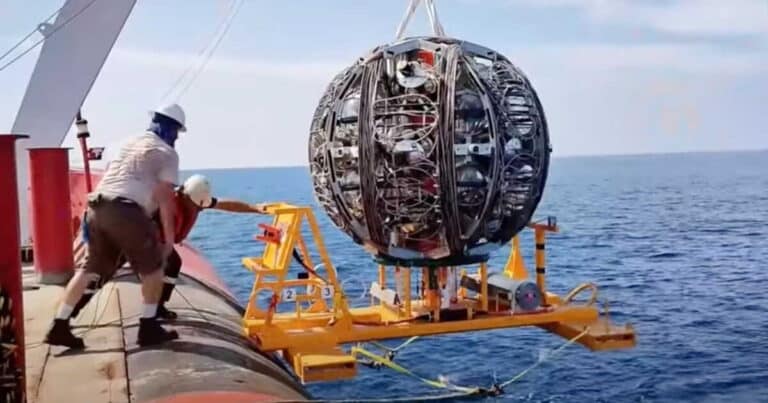
A particle from the farthest reaches of the universe has been detected at the bottom of the Mediterranean Sea.
How did your country report this? Share your view in the comments.
Diverging Reports Breakdown
A particle from the farthest reaches of the universe has been detected at the bottom of the Mediterranean Sea.
In February 2023, the KM3NeT telescope, located 2,450 meters beneath the sea surface, captured evidence of an ultra-high-energy neutrino. Neutrinos, often called “ghost particles,” are electrically neutral and incredibly lightweight – approximately one million times lighter than electrons. This cosmic messenger traveled billions of light-years from a distant galaxy before its momentous arrival on Earth. This discovery provides a rare glimpse into extreme cosmic events, potentially involving massive black holes observed approaching our cosmic neighborhood. Each detection adds a piece to our understanding of the universe’s most energetic processes, much like how new telescopes help reveal hidden objects in our solar system, says Paschal Coyle, a neutrinos physicist at Aix-Marseille University and KM3 NeT spokesperson. The discovery occurred when only 10% of its planned sensors were operational.
Hunting for cosmic messengers in Mediterranean depths
The Mediterranean Sea has become an unexpected observatory for some of the universe’s most elusive particles. Neutrinos, often called “ghost particles,” are electrically neutral and incredibly lightweight – approximately one million times lighter than electrons. Their minimal interaction with matter allows billions to pass through every square centimeter of Earth daily without leaving a trace.
The KM3NeT telescope employs chains of light-sensitive detectors anchored to the seafloor off Sicily’s coast, with a smaller array near Toulon, France. These sophisticated instruments are designed to detect the faint signals produced when neutrinos interact with matter in or near the detector. When these rare interactions occur, they produce charged particles like muons that emit detectable light.
“These particles provide unique insights into the most violent cosmic events,” explains Paschal Coyle, neutrino physicist at Aix-Marseille University and KM3NeT spokesperson. Unlike other cosmic messengers, neutrinos travel unimpeded through space, carrying information from mysterious deep space phenomena directly to our detectors.
The Mediterranean location offers significant advantages for neutrino detection. The deep, clear seawater provides an ideal medium for observing the telltale flashes of light produced by neutrino interactions, while simultaneously shielding the detectors from atmospheric interference. Similar detection methods have been employed in other extreme environments, much like ancient frozen structures emerging from ice reveal long-hidden secrets.
Record-breaking cosmic particle reveals universal secrets
What makes the February 2023 detection extraordinary is its unprecedented energy level. Published in Nature on February 12, 2025, the research reports a neutrino carrying an estimated 120 PeV (petaelectronvolts) of energy – twenty times greater than any previously detected neutrino. This cosmic messenger traveled billions of light-years from a distant galaxy before its momentous arrival on Earth.
The discovery occurred during KM3NeT’s construction phase when only 10% of its planned sensors were operational. “We had to convince ourselves this wasn’t something strange with the telescope,” Coyle noted. The particle’s nearly horizontal trajectory, heading toward Greece, convinced scientists they had detected a genuine cosmic neutrino rather than a muon produced by atmospheric cosmic rays.
Elisa Resconi, a neutrino physicist involved with the IceCube project (which first detected cosmic neutrinos in 2012 at the South Pole), described the event as “colossal.” This discovery provides a rare glimpse into extreme cosmic events, potentially involving massive black holes observed approaching our cosmic neighborhood.
Origins of ultra-high-energy cosmic particles
The birthplace of such energetic neutrinos remains one of astrophysics’ most intriguing questions. Leading theories suggest they emerge from cataclysmic events involving supermassive black holes, similar to the chaotic environment observed when the James Webb Telescope captured our galaxy’s central black hole. Other potential sources include supernova explosions, gamma-ray bursts, or active galactic nuclei.
The Mediterranean detector provides a complementary view to other neutrino observatories worldwide, creating a global network scanning for these rare cosmic messengers. Each detection adds a piece to our understanding of the universe’s most energetic processes, much like how new telescopes help reveal hidden objects in our solar system.
Since the groundbreaking detection, KM3NeT has expanded from 21 detector chains to 33, significantly enhancing its sensitivity. This underwater observatory, along with similar projects in unexpected locations like ancient underwater volcanoes hosting unique ecosystems, demonstrates humanity’s ingenuity in exploring cosmic frontiers.
As KM3NeT continues to monitor the Mediterranean depths, scientists anticipate more ultra-high-energy neutrino detections, potentially revealing the mysterious cosmic engines powering these extraordinary particles. Each detection brings us closer to understanding the most violent and energetic processes shaping our universe across billions of light-years.
